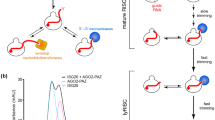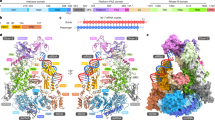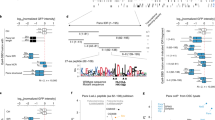Abstract
The assembly of RNA-induced silencing complex (RISC) is a key process in small RNA–mediated gene silencing. In humans, small interfering RNAs (siRNAs) and microRNAs (miRNAs) are incorporated into RISCs containing the Argonaute (AGO) subfamily proteins Ago1–4. Previous studies have proposed that, unlike Drosophila melanogaster RISC assembly pathways, human RISC assembly is coupled with dicing and is independent of ATP. Here we show by careful reexamination that, in humans, RISC assembly and dicing are uncoupled, and ATP greatly facilitates RISC loading of small-RNA duplexes. Moreover, all four human AGO proteins show remarkably similar structural preferences for small-RNA duplexes: central mismatches promote RISC loading, and seed or 3′-mid (guide position 12–15) mismatches facilitate unwinding. All these features of human AGO proteins are highly reminiscent of fly Ago1 but not fly Ago2.
This is a preview of subscription content, access via your institution
Access options
Subscribe to this journal
Receive 12 print issues and online access
$189.00 per year
only $15.75 per issue
Buy this article
- Purchase on Springer Link
- Instant access to full article PDF
Prices may be subject to local taxes which are calculated during checkout






Similar content being viewed by others
References
Hutvagner, G. & Simard, M.J. Argonaute proteins: key players in RNA silencing. Nat. Rev. Mol. Cell Biol. 9, 22–32 (2008).
Carthew, R.W. & Sontheimer, E.J. Origins and mechanisms of miRNAs and siRNAs. Cell 136, 642–655 (2009).
Ghildiyal, M. & Zamore, P.D. Small silencing RNAs: an expanding universe. Nat. Rev. Genet. 10, 94–108 (2009).
Siomi, H. & Siomi, M.C. On the road to reading the RNA-interference code. Nature 457, 396–404 (2009).
Ishizuka, A., Siomi, M.C. & Siomi, H. A Drosophila fragile X protein interacts with components of RNAi and ribosomal proteins. Genes Dev. 16, 2497–2508 (2002).
Meister, G. et al. Identification of novel Argonaute-associated proteins. Curr. Biol. 15, 2149–2155 (2005).
Hock, J. et al. Proteomic and functional analysis of Argonaute-containing mRNA-protein complexes in human cells. EMBO Rep. 8, 1052–1060 (2007).
Landthaler, M. et al. Molecular characterization of human Argonaute-containing ribonucleoprotein complexes and their bound target mRNAs. RNA 14, 2580–2596 (2008).
Matranga, C., Tomari, Y., Shin, C., Bartel, D.P. & Zamore, P.D. Passenger-strand cleavage facilitates assembly of siRNA into Ago2-containing RNAi enzyme complexes. Cell 123, 607–620 (2005).
Rand, T.A., Petersen, S., Du, F. & Wang, X. Argonaute2 cleaves the anti-guide strand of siRNA during RISC activation. Cell 123, 621–629 (2005).
Miyoshi, K., Tsukumo, H., Nagami, T., Siomi, H. & Siomi, M.C. Slicer function of Drosophila Argonautes and its involvement in RISC formation. Genes Dev. 19, 2837–2848 (2005).
Leuschner, P.J., Ameres, S.L., Kueng, S. & Martinez, J. Cleavage of the siRNA passenger strand during RISC assembly in human cells. EMBO Rep. 7, 314–320 (2006).
Kawamata, T., Seitz, H. & Tomari, Y. Structural determinants of miRNAs for RISC loading and slicer-independent unwinding. Nat. Struct. Mol. Biol. 16, 953–960 (2009).
Okamura, K., Ishizuka, A., Siomi, H. & Siomi, M.C. Distinct roles for Argonaute proteins in small RNA-directed RNA cleavage pathways. Genes Dev. 18, 1655–1666 (2004).
Förstemann, K., Horwich, M.D., Wee, L., Tomari, Y. & Zamore, P.D. Drosophila microRNAs are sorted into functionally distinct Argonaute complexes after production by Dicer-1. Cell 130, 287–297 (2007).
Tomari, Y., Du, T. & Zamore, P.D. Sorting of Drosophila small silencing RNAs. Cell 130, 299–308 (2007).
Jannot, G., Boisvert, M.E., Banville, I.H. & Simard, M.J. Two molecular features contribute to the Argonaute specificity for the microRNA and RNAi pathways in C. elegans. RNA 14, 829–835 (2008).
Steiner, F.A. et al. Structural features of small RNA precursors determine Argonaute loading in Caenorhabditis elegans. Nat. Struct. Mol. Biol. 14, 927–933 (2007).
Mi, S. et al. Sorting of small RNAs into Arabidopsis Argonaute complexes is directed by the 5′ terminal nucleotide. Cell 133, 116–127 (2008).
Montgomery, T.A. et al. Specificity of Argonaute7-miR390 interaction and dual functionality in TAS3 trans-acting siRNA formation. Cell 133, 128–141 (2008).
Takeda, A., Iwasaki, S., Watanabe, T., Utsumi, M. & Watanabe, Y. The mechanism selecting the guide strand from small RNA duplexes is different among Argonaute proteins. Plant Cell Physiol. 49, 493–500 (2008).
Meister, G. et al. Human Argonaute2 mediates RNA cleavage targeted by miRNAs and siRNAs. Mol. Cell 15, 185–197 (2004).
Liu, J. et al. Argonaute2 is the catalytic engine of mammalian RNAi. Science 305, 1437–1441 (2004).
Azuma-Mukai, A. et al. Characterization of endogenous human Argonautes and their miRNA partners in RNA silencing. Proc. Natl. Acad. Sci. USA 105, 7964–7969 (2008).
Su, H., Trombly, M.I., Chen, J. & Wang, X. Essential and overlapping functions for mammalian Argonautes in microRNA silencing. Genes Dev. 23, 304–317 (2009).
Khvorova, A., Reynolds, A. & Jayasena, S.D. Functional siRNAs and miRNAs exhibit strand bias. Cell 115, 209–216 (2003).
Schwarz, D.S. et al. Asymmetry in the assembly of the RNAi enzyme complex. Cell 115, 199–208 (2003).
Tomari, Y. et al. RISC assembly defects in the Drosophila RNAi mutant armitage. Cell 116, 831–841 (2004).
Pham, J.W., Pellino, J.L., Lee, Y.S., Carthew, R.W. & Sontheimer, E.J.A. Dicer-2–dependent 80s complex cleaves targeted mRNAs during RNAi in Drosophila. Cell 117, 83–94 (2004).
Nykanen, A., Haley, B. & Zamore, P.D. ATP requirements and small interfering RNA structure in the RNA interference pathway. Cell 107, 309–321 (2001).
Gregory, R.I., Chendrimada, T.P., Cooch, N. & Shiekhattar, R. Human RISC couples microRNA biogenesis and posttranscriptional gene silencing. Cell 123, 631–640 (2005).
Maniataki, E. & Mourelatos, Z. A human, ATP-independent, RISC assembly machine fueled by pre-miRNA. Genes Dev. 19, 2979–2990 (2005).
Macrae, I.J., Ma, E., Zhou, M., Robinson, C.V. & Doudna, J.A. In vitro reconstitution of the human RISC-loading complex. Proc. Natl. Acad. Sci. USA 105, 512–517 (2008).
Tomari, Y. & Zamore, P.D. Perspective: machines for RNAi. Genes Dev. 19, 517–529 (2005).
Preall, J.B., He, Z., Gorra, J.M. & Sontheimer, E.J. Short interfering RNA strand selection is independent of dsRNA processing polarity during RNAi in Drosophila. Curr. Biol. 16, 530–535 (2006).
Rivas, F.V. et al. Purified Argonaute2 and an siRNA form recombinant human RISC. Nat. Struct. Mol. Biol. 12, 340–349 (2005).
O'Sullivan, W.J. & Perrin, D.D. The stability constants of metal-adenine nucleotide complexes. Biochemistry 3, 18–26 (1964).
Liu, Q. et al. R2D2, a bridge between the initiation and effector steps of the Drosophila RNAi pathway. Science 301, 1921–1925 (2003).
Tomari, Y., Matranga, C., Haley, B., Martinez, N. & Zamore, P.D. A protein sensor for siRNA asymmetry. Science 306, 1377–1380 (2004).
Iwasaki, S., Kawamata, T. & Tomari, Y. Drosophila Argonaute1 and Argonaute2 employ distinct mechanisms for translational repression. Mol. Cell 34, 58–67 (2009).
Behm-Ansmant, I. et al. mRNA degradation by miRNAs and GW182 requires both CCR4-NOT deadenylase and DCP1–DCP2 decapping complexes. Genes Dev. 20, 1885–1898 (2006).
Eulalio, A., Tritschler, F. & Izaurralde, E. The GW182 protein family in animal cells: New insights into domains required for miRNA-mediated gene silencing. RNA 15, 1433–1442 (2009).
Martinez, J., Patkaniowska, A., Urlaub, H., Luhrmann, R. & Tuschl, T. Single-stranded antisense siRNAs guide target RNA cleavage in RNAi. Cell 110, 563–574 (2002).
Kanellopoulou, C. et al. Dicer-deficient mouse embryonic stem cells are defective in differentiation and centromeric silencing. Genes Dev. 19, 489–501 (2005).
Murchison, E.P., Partridge, J.F., Tam, O.H., Cheloufi, S. & Hannon, G.J. Characterization of Dicer-deficient murine embryonic stem cells. Proc. Natl. Acad. Sci. USA 102, 12135–12140 (2005).
Haley, B., Tang, G. & Zamore, P.D. In vitro analysis of RNA interference in Drosophila melanogaster. Methods 30, 330–336 (2003).
Ui-Tei, K. et al. Functional dissection of siRNA sequence by systematic DNA substitution: modified siRNA with a DNA seed arm is a powerful tool for mammalian gene silencing with significantly reduced off-target effect. Nucleic Acids Res. 36, 2136–2151 (2008).
Acknowledgements
We acknowledge T. Tuschl (Rockefeller University) for pIRESneo-Flag-HA-Ago1–4 plasmids, C. Cepko (Harvard Medical School) for pCAGEN vector and M. and H. Siomi (Keio University) for anti–human Ago2. We are also grateful to T. Katoh, T. Suzuki and K. Ui-Tei for helpful discussion, T. Okazaki for his extensive technical assistance and A. Nomoto for his generous support and encouragement. We thank the members of the Tomari laboratory, S. Kawaoka, H. Sasaki, K. Förstemann and H. Seitz for suggestions and critical comments on the manuscript. This work was supported in part by a Grant-in-Aid for Young Scientists (A) to Y.T. and a Grant-in-Aid for Young Scientists (B) to T.K. from the Japan Ministry of Education, Culture, Sports, Science and Technology, a grant from the Welch foundation to Q.L. and a Carrier Development Award from The International Human Frontier Science Program Organization to Y.T. Y.T. is a Japan Science and Technology Agency Precursory Research for Embryonic Science and Technology researcher.
Author information
Authors and Affiliations
Contributions
M.Y. performed in vivo experiments; M.Y., T.K. and S.I. performed biochemical experiments; Z.P., X.Y. and Q.L. expressed and purified recombinant Ago2 and performed initial experiments using it; Y.T. supervised the study; M.Y. and Y.T. wrote the manuscript; all authors discussed the results and approved the manuscript.
Corresponding author
Supplementary information
Supplementary Text and Figures
Supplementary Figures 1–4 (PDF 754 kb)
Rights and permissions
About this article
Cite this article
Yoda, M., Kawamata, T., Paroo, Z. et al. ATP-dependent human RISC assembly pathways. Nat Struct Mol Biol 17, 17–23 (2010). https://doi.org/10.1038/nsmb.1733
Received:
Accepted:
Published:
Issue Date:
DOI: https://doi.org/10.1038/nsmb.1733
This article is cited by
-
MicroRNAs: a crossroad that connects obesity to immunity and aging
Immunity & Ageing (2022)
-
GTSF1 accelerates target RNA cleavage by PIWI-clade Argonaute proteins
Nature (2022)
-
MicroRNA biogenesis proteins follow tissue-dependent expression during freezing in Dryophytes versicolor
Journal of Comparative Physiology B (2022)
-
AGO2 localizes to cytokinetic protrusions in a p38-dependent manner and is needed for accurate cell division
Communications Biology (2021)
-
No evidence for viral small RNA production and antiviral function of Argonaute 2 in human cells
Scientific Reports (2019)



